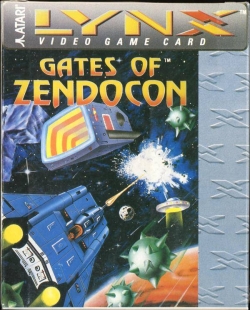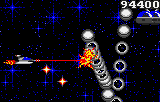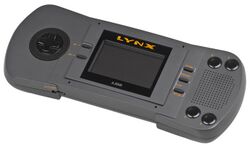Gates of Zendocon
Topic: Software
 From HandWiki - Reading time: 6 min
From HandWiki - Reading time: 6 min
| Gates of Zendocon | |
|---|---|
 Cover art in all regions | |
| Developer(s) | Epyx |
| Publisher(s) |
|
| Designer(s) | Peter M. Engelbrite |
| Programmer(s) | Peter M. Engelbrite |
| Artist(s) | Peter M. Engelbrite Matthew Crysdale Arthur Koch |
| Composer(s) | Robert Vieira Alex Rudis |
| Platform(s) | Atari Lynx |
| Release | |
| Genre(s) | Scrolling shooter |
| Mode(s) | Single-player |
Gates of Zendocon is a horizontally scrolling shooter developed by Epyx and published by Atari Corporation in 1989 in North America and Europe for the Atari Lynx. It was released in Japan on December 23 of the same year, where it was distributed by Mumin Corporation.[1][2] One of the first games written for the platform, it was one of the launch titles that were released along with the system in North America.
In the game, the eponymous evil spider has trapped the player's space fighter in his web of universes, which are interconnected by a series of teleportation gates and riddled with alien bases, with the primary objective of finding and defeating him while recruiting friendly allies along the way. Programmed by Todd's Adventures in Slime World author Peter Engelbrite, Gates of Zendocon began its development prior to the existence of functional Lynx hardware.
Gates of Zendocon received positive reception from critics after its initial release, with praise towards the presentation, originality and gameplay but the sound department received criticism. An updated conversion for the Atari Jaguar was planned but never went into full production due to a lack of internal interest.
Gameplay
Gates of Zendocon is a horizontally scrolling shoot 'em up game where the player take control of an unnamed space fighter craft across 51 non-linear levels ("universes"), with the main objective being finding and defeating the evil spider Zendocon by passing through teleportation gates to do so, while battling against an assortment of Zendocon's army.[3][4] During gameplay, there are a number of friendly alien allies who were slaved by Zendocon that aid the player in their journey and protect the ship. Most of the levels are riddled with enemies and if the player's ship is hit by an enemy or projectile, it will reflect the amount of damage taken as a result: it can lose the laser tip and the engine before the last hit that will obliterate the player's ship. In addition, there is a hidden level inside the game where the player can earn high scores by destroying the faces of the game's creators.[5][6]
Development
Gates of Zendocon was written by Peter Engelbrite when he worked at Epyx as games developer and programmer. He also worked on Atari 2600 conversion of other titles from the company such as California Games, Summer Games and Winter Games.[7] In an online interview with website The Atari Times, Engelbrite recounted about the development process of the game, stating that work on the project began before functional Atari Lynx hardware existed and wrote an emulator of the console on the Apple II 8-bit microcomputer, setting up the system's graphical data structures but displaying the sprites as ASCII text.[7]
Later during development, an early revision of the Lynx capable of displaying raster graphics was made, with the game running for the first time on actual hardware, albeit at a slow frame rate.[7][8] Atari composer Alex Rudis was also involved during the production of the project, recalling the process of the developer's pictures in the hidden level on another interview with The Atari Times, which involved using a video camera to scan the image with Dave Needle and other team members freezing the images in order to be clear, while Rudis rotated his portrait as the scanning occurred to make it look distorted.[9] Electronic Gaming Monthly also revealed that other members were involved in its production, among them being Lynx co-inventor RJ Mical, although their roles were not specified.[5]
Release
Gates of Zendocon was one of the launch titles during the initial release of the Lynx in 1989 along with California Games, Blue Lightning, and Electrocop. It was also released in Europe around the same time period and later in Japan on December 23 of the same year, where it was distributed by Mumin Corporation instead and the difference between the international and Japanese releases is that the latter came bundled with an instruction manual in Japanese.[1][2][10] The game was first showcased to the public during the International Summer Consumer Electronics Show 1989, along with the system.[11][12]
Reception
| Reception | ||||||||||||||||||||||||||||||
|---|---|---|---|---|---|---|---|---|---|---|---|---|---|---|---|---|---|---|---|---|---|---|---|---|---|---|---|---|---|---|
| ||||||||||||||||||||||||||||||
Gates of Zendocon garnered positive reception.[26] In a review for STart, Clayton Walnum called the game "the obligatory, horizontally-scrolling, outer-space shoot-em-up", and said it would only appeal to fans of the genre due to its limited depth and weak use of the Lynx hardware.[27] Robert A. Jung also reviewed the game which was published to IGN. He noted that "Underneath the average graphics and average sound is a well-rounded, pretty diverse action game" and called it "a good buy". Giving a final score of 7 out of 10.[6]
Legacy
In 1993, Atari Corp. requested several Epyx titles in order to be converted and release to the then-upcoming Atari Jaguar, with Gates of Zendocon among the list of selected titles.[28] After the initial discontinuation of Protector on Jaguar in 1995, Atari suggested to use its engine in a proposed update of Gates of Zendocon for the system but Christopher Weaver, then-president of Bethesda Softworks, was not interested and no actual development started on this version due to this decision.[29]
References
- ↑ 1.0 1.1 "LYNX Soft > 1989-1991" (in ja). http://tk-nz.game.coocan.jp/gamedatabase/software/DB_ATM_LX1989-1991.html.
- ↑ 2.0 2.1 Philippe, Jean (2002). "La console lynx au Japon - La LYNX ce fait japonaise" (in fr). http://jeanphilippe.garin.perso.neuf.fr/reportage%20Japan.html.
- ↑ Gates of Zendocon game manual (Atari Lynx, US)
- ↑ Barbato, Steven (July 10, 2020). "Gates of Zendocon". Hardcore Gaming 101. http://www.hardcoregaming101.net/xexex/.
- ↑ 5.0 5.1 Kosher, Mike (June 1990). "Tricks of the Trade - Secret Tricks, Codes, And Strategies - Gates of Zendocon - Secret Designers Room". Electronic Gaming Monthly (Sendai Publishing) (11): 35. https://archive.org/details/Electronic_Gaming_Monthly_11/page/n35.
- ↑ 6.0 6.1 6.2 A. Jung, Robert (July 6, 1999). "Gates of Zendocon - Don't judge the book by its cover -- Gates of Zendocon is surprisingly fun". IGN. Ziff Davis. https://www.ign.com/articles/1999/07/07/gates-of-zendocon.
- ↑ 7.0 7.1 7.2 D. George, Gregory (October 25, 2002). "The Games of Peter Engelbrite - Christians play games too!". http://www.ataritimes.com/index.php?ArticleIDX=295.
- ↑ Hawken, Kieren (May 2014). "Lynx Awakening: An Atari Lynx Retrospective". Retro Gamer (Imagine Publishing) (129): 48–55.
- ↑ D. George, Gregory (September 9, 2002). "A conversation with Lx Rudis - Atari's most famous musician speaks!". http://www.ataritimes.com/index.php?ArticleIDX=282#lynxgames.
- ↑ Covell, Chris (March 3, 2016). "Japanese Secrets! - Other Systems: Jul. - Sept. 1989 - Atari Lynx Announcement". https://www.chrismcovell.com/secret/OTH_1989Q3.html.
- ↑ "Hot From The USA - ACES From The Biggest Computer Show On Earth". ACE (EMAP) (23): 26–27. August 1989. https://archive.org/stream/ace-magazine-23/ACE_Issue_23_1989_Aug#page/n25/mode/2up. Retrieved 2019-04-19.
- ↑ Rignall, Julian (August 1989). "Review - Atari's Unbelievable Advantage". Computer and Video Games (Future Publishing) (93): 8–9. https://archive.org/details/cvg-magazine-093b/page/n7.
- ↑ Knight, Kyle. "Gates of Zendocon - Review". http://www.allgame.com/game.php?id=16839&tab=review.
- ↑ "Report - Lynx Da Geht Der Luchs Ab! - Die Weichteile - Gates of Zendocon". Aktueller Software Markt (Tronic Verlag) (40): 95–96. March 1990. https://archive.org/details/Aktueller_Software_Markt_-_Ausgabe_1990.03/page/n94.
- ↑ "Le cahier des consoles n°1: Lynx - Gates of Zendocon". Amstar (Soracom Editions) (49): 44. September 1990. http://download.abandonware.org/magazines/Amstar/amstar_numero49/amstar_49-44.jpg.
- ↑ Rignall, Julian (November 1990). "Complete Guide to Consoles - The Complete Games Guide - Lynx - Gates of Zendocon". Computer and Video Games Mean Machines (EMAP) (4): 66–67. https://archive.org/details/Complete_Guide_to_Consoles_Volume_IV_1990_EMAP_Publishing_GB/page/n65.
- ↑ M. Rosenthal, Marshal (February 1990). "Consoles - Atari Lynx - Reviews - Gates of Zendocon". The Games Machine (Newsfield Publications) (27): 36–37. https://archive.org/stream/the-games-machine-27/TheGamesMachine27#page/n35/mode/2up. Retrieved 2019-04-07.
- ↑ "Test - Lynx - Gates of Zendocon". Génération 4 (Computec Media France) (22): 71. May 1990. http://download.abandonware.org/magazines/Generation%204/generation4_numero022/Gen4%20N022%20-%20Mai%201990%20-%20Page%20071.jpg.
- ↑ "En Cartel - Gates of Zendocon (Lynx) - Dulce venganza". Hobby Consolas (Axel Springer SE) (2): 79. November 1991. https://archive.org/stream/hobbyconsolas002_201909#page/n78/mode/1up.
- ↑ Demoly, Jean-Marc (March 1990). "Consoles - Lynx - Lynx Test - Gates of Zendocon". Joystick (Anuman Interactive) (3): 43. http://download.abandonware.org/magazines/Joystick/joystick_numero003/joystick%20-%20N%B03%20-%20mars%201990%20-%20page042%20et%20page043.jpg.
- ↑ "Console News - Lynx: Gates of Zendocon". Joystick (Anuman Interactive) (Hors-Serie 3): 142. July–August 1991. http://download.abandonware.org/magazines/Joystick/joystick_numerohs03/Joystick%20HS%20n%b03%20-%20Juillet%20Ao%fbt%201991%20-%20Page%20142.jpg.
- ↑ J.G.V. (November 1990). "Punto de mira - Consola Lynx: Gates of Zendocon". Micromanía (HobbyPress) 2 (30): 52. https://archive.org/stream/micromania-segunda-epoca-30#page/n51/mode/1up.
- ↑ Scamps, Olivier (October 1990). "Tests De Jeu - Lynx - Gates of Zendocon". Player One (Média Système Édition) (2): 17. http://download.abandonware.org/magazines/Player%20One/playerone_numero002/Player%20One%20002%20-%20Page%20017%20%281990-10%29.jpg.
- ↑ Fisch, Henrik (March 1990). "Power Thema - Lynx im Test". Power Play (Future Verlag) (24): 26–27. https://www.kultboy.com/index.php?site=t&id=4373&s=2.
- ↑ Ponting, Tim (March 1990). "Review - Console - Three Sizzling Atari Lynx Games Reviewed - Gates of Zendacon". Zero (Dennis Publishing) (5): 50. https://archive.org/stream/zero-magazine-05/Zero_05_Mar_1990#page/n49/mode/1up.
- ↑ Molyneaux, Maurice (September 1990). "Gaming on the Go - Gates of Zendocon by Epyx". VideoGames & Computer Entertainment (Larry Flynt Publications) (20).
- ↑ Walnum, Clayton (December 1990). "The Lynx Collection - Gates of Zendocon". STart (Antic Publishing) (39): 67–73. https://archive.org/stream/STart-Magazine-Issue-39#page/n66/mode/1up. Retrieved 2019-04-08.
- ↑ Dragon, Lost (July 6, 2017). "The EPYX Titles Atari Wanted on Lynx...". http://forums.atari.io/index.php/topic/3333-the-epyx-titles-atari-wanted-on-lynx/.
- ↑ Joergen, Bech. "Protector - Songbird Productions". http://home1.inet.tele.dk:80/jbech/protectorsongbird.htm.
External links
- Gates of Zendocon at AtariAge
- Gates of Zendocon at GameFAQs
- Gates of Zendocon at Giant Bomb
- Gates of Zendocon at MobyGames
 |
 KSF
KSF

